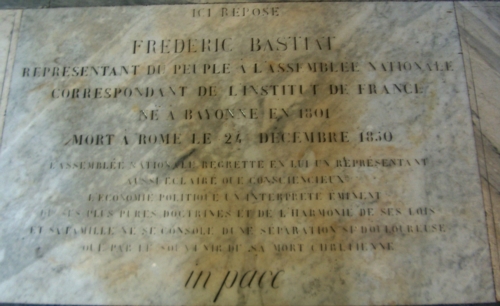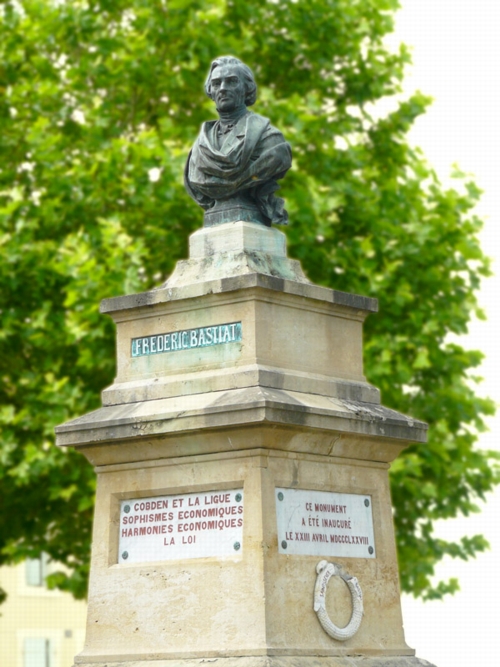
FRÉDÉRIC BASTIAT (1801-50): A CHRONOLOGY OF HIS LIFE AND WORK
[Updated January 18, 2017]
 |
 |
For further information:
- See other material on and by Frédéric Bastiat at this site
- the Bastiat bio page at the Online Library of Liberty
- timeline of Bastiat's life and work: Part 1 The "Unseen" Bastiat (1801-1844) [PDF]
- timeline of Bastiat's life and work: Part 2 The "Seen" Bastiat (1844-1850) [PDF]
- the excellent "Chronologie de la vie et des oeuvres Frédéric Bastiat" by Jean-Claude Paul-Dejean a the Bastiat Circle website (in French)
Frédéric Bastiat (1801-1850): A Chronology of his Life and Work by Dr. David M. Hart
[I have made a play on words from the title of one his most brilliant essays “What is Seen and What is not Seen” (June 1850) in order to divide FB's life into two periods. The first period, the "Unseen" Bastiat, was from 1801 to 1844 when he was an obscure provincial magistrate and gentleman land-owner in Les Landes in south west France. The second period, the "Seen" Bastiat, covers the period from 1844 to his death on Christmas Eve in 1850 when he rose to some prominence in Paris as an organisor for the free trade movement, an economic journalist and theorist, and a member of the Chamber of Deputies during the 1848 Revolution and Second Republic.]
Contents:
- The Early “Unseen” FB: Provincial Magistrate and Landowner (1801-1844)
- The “Seen” Bastiat I: The Free Trade Organizer and Journalist (1844-1848)
- The “Seen” Bastiat II: The Politician during the 1848 Revolution and the Second Republic (1848-1850)
- The “Seen” Bastiat III: The Theorist of Political Economy (1849-1850)
- Chronological List of his Major Works
- Short list at this site (below)
- More detailed list at the OLL website
- Gravestone (Rome) and Monument (Mugron)
1. The Early “Unseen” FB: Provincial Magistrate and Landowner (1801-1844)
- born 30 June 1801 in Bayonne in SW France [died 24 December 1850, Rome]; father Pierre B merchant in Spanish trade; grew up in town at mouth of Ardour R. where it enters Atlantic Ocean; major artery for wine trade, trade with neighbouring Spain [See maps]
- mother Marie-Julie died when he was 7, orphaned at the age of 9 when father died; brought up by his aunt Justine; educated initially by his grandfather
- port towns like Bayonne suffered during economic warfare of Naopleon (Continental Bocade to keeps British goods out of Europe during war); post-war economic dislocation and French tariffs in 1816 which were increased in 1819; FB would have witnessed smuggling as he lived close to coast and Spanish border
- enjoyed an innovative education at College of Saint-Sever and then Benedictine École de Sorèze (1814-1818) where school encouraged study of modern subjects (languages English, Italian, Spanish) and not Greek and Roman classics (which FB despised as culture of conquest, slavery, and plunder); international student body; learnt cello (life long ove of music - opera)
- entered uncle’s business in 1818 before completing school
- inherited grandfather’s estate in 1825 and became gentleman farmer in
Mugron (estate called “Sengresse”); unsuccessfully tried to introduce
agricultural reforms for his tenants
1830 - participates in 1830 “July Revolution” by joining protests in Bayonne in favour of the new regime which becomes the July Monarchy - February 1831 FB marries Marie Clothilde Hiart; quickly separates from her and severs all ties; possibly married only for dowry to expand his estate; suggestion of a son (?)
- 28 May 1831 - appointed justice of the peace in Mugron canton
- 17 Nov. 1833 - elected Councillor General for Mugron canton; reelected Nov. 1839
- 1831-1842 - several unsuccessful attempts to be elected to various local political bodies
- continued education with voracious reading and study of literature and economics (read English, Italian, Spanish); joined town reading and discussion group; close to friend Félix Coudroy with whom he discussed everything during long walks in country-side
- went to Spain in 1840 to set up insurance company (unsuccessful)
- discovered RC’s Anti-Corn Law League while preparing for his discussion group
- wrote article in 1844 on the impact of tariffs in France and England which he submitted as complete unknown to JDE; became instantly famous in political eco. circles
2. The “Seen” Bastiat I: The Free Trade Organizer and Journalist (1844-1848)
- Oct. 1844 publication of “De l’influence des tarifs français et anglais sur l’avenir des deux peiuples” in JDE
- November 1844 - begins correspondence with Richard Cobden
- 1845 - trip to Paris to make contact with SEP and then England to visit Cobden and League
- 1845 - 1st book published on Cobden et al ligue;
- success of JDE article leads to other articles which become Economic Sophisms (1st Series) (1845) followed by part 2 in 1848)
- 24 Jan. 1846 - FB elected a corresponding member of the Institute
- Bordeaux Chamber of Commerces urges Franco-Belgian customs treaty
- FB writes articles for local newspapers and helps start Bordeaux Free
Trade Association 23 February 1846
goes to Paris to form national Free Trade Association 10 May 1846- members include Auguste Blanqui, Michel Chevalier, Charles Dunoyer, Gustave de Molinari, Horace Say (son)
- 18 August dinner to acknowledge RC (FB gives toast)
- FB aspires to become “French Cobden”
- FB writes articles for local newspapers and helps start Bordeaux Free
Trade Association 23 February 1846
- 29 Nov. 1846 1st issue of magazine Le libre échange - 4-8 page free trade weekly paper (lasts until 16 Apr. 1848)
- 1847 - French Chamber debates bill to cut French tariffs but it defeated by protectionist lobby
- outbreak of Feb 1848 Revolution sees rise of socialist movements; free trade movement in France discouraged; holds last public meeting 15 March 1848; Libre-Échange last issue 16 April 1848
- July 1847 gives a course on political economy at the School of Law (foundation of Ec. Harmonies)
3. The “Seen” Bastiat II: The Politician during the 1848 Revolution and the Second Republic (1848-1850)
- abdication of Louis Philippe 24 Feb. 1848; declaration of 2nd Republic 25 Feb
- FB immediately founds La République française (then Jacques Bonhomme ed. by Charles Coquelin and G. de Molianri) after outbreak of revolution; designed to appeal to ordinary people and to show them the dangers of socialism and protectionism
- 23 April 1848 FB elected deputy of Les Landes to Constituent Assembly
- 13 May 1848 reelected to Legislative Assembly and appointed vice-president of Finance Committee
- Aug. 1949 attends Paris Peace Congress organised by V. Hugo
- legislative activities
- supports motion to prevent civil servants also serving as elected representatives
- opposes government motions for “right to work”, limiting working day to 10 hours, unemployment subsidies in National Workshops
- opposes govt policy to convict socialist Louis Blanc for activities during June Days uprising
- votes in favour of new constitution and Gen. Cavaignac for president
- votes against ban on voluntary trade unions
- votes against imposition of martial law
- opposes govt. proposal to send troops to Rome to protect Pope
- opposes govt. education policy (Falloux Law)
4. The “Seen” Bastiat III: The Theorist of Political Economy (1849-1850)
- attends meetings of the Société d’économie politique - controversial positions on nature of rent (landed rent) and ultra-minimalist size of government provoke spirited debates within the SEP
- July 1847 gives a course on political economy at the School of Law (foundation of Ec. Harmonies)
- writes many articles for the Journal des économistes 1844-1850; offered job of editing JDE but turns it down
- the rush to finish the Economic Harmonies (part 1 Feb. 1850, 2nd part appears posthumously)
- on doctor's orders leaves Paris to recuperate in Italy; dies in Rome on 24 December 1850
5. Chronological List of his Major Works
- 1844 - “De l’influence des tarifs français et anglais sur l’avenir des deux peuples” in JDE Oct. 1844
- 1845
- Cobden et al ligue [Cobden and the League]
- part 1 of Economic Sophisms with 22 essays (part 2 appears in 1848- with 17 essays)
- "Petition of the Candle-makers"
- 1846 - editor of Le libre échange (until 16 Apr. 1848)
- 1848
- “Propriété et loi” [Property and Law]
- “Justice et franternité” [Justice and Fraternity]
- “Propriété et spoliation” [Property and Plunder]
- “L’État” [The State]
- 1849
- “Protectionnisme et communisme” [Protectionism and Communism]
- “Capitle et rente” [Capital and Rent]
- “Paix et liberté ou le budget républicain” [Peace and Liberty, or the Republican Budget]
- “Les incompatibilités parlementaires” [Parliamentary Conflicts of Interest]
- “Maudit l’argent!” [Damn Money!]
- 1850
- part 1 of his magnum opus Economic Harmonies (part 2 published posthumously)
- “Intérêt et principal” [Interest and Principal]
- “Spoliation et la loi” [Plunder and Law]
- “La loi” [The Law]
- “Baccalauréat et socialisme” [Baccalaureat and Socialism]
- “Ce qu’on voit et ce qu’on ne voit pas” [What is Seen and What is Not Seen]
6. gravestone (Rome) and Monument (Mugron)
Bastiat was buried at the church of Saint-Louis de Français in Rome. His gravestone bears the following inscription:
 |
HERE LIES FRÉDÉRIC BASTIAT Parliament will miss such an enlightened and conscientious representative, political economy, such an eminent exponent of its purest doctrines and of the harmony of its laws. His family will only find consolation for such a painful separation in the memory of his Christian death in pace |
The Society for Political Economy raised money to build a monument to Bastiat which was erected in Mugron and an inauguration ceremony was held on 23 April, 1878.
 |